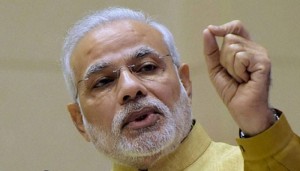 Even though India’s star may be rising because the IMF and Moody’s (the famous international credit rating agency) have forecast 7.5 per cent growth, there are serious problems ahead for India, especially in the agricultural sector. The recent suicide by a farmer from Rajasthan, Gajendra Singh, in the national capital has unearthed the kind of stress and desperation farmers are experiencing.
Even though India’s star may be rising because the IMF and Moody’s (the famous international credit rating agency) have forecast 7.5 per cent growth, there are serious problems ahead for India, especially in the agricultural sector. The recent suicide by a farmer from Rajasthan, Gajendra Singh, in the national capital has unearthed the kind of stress and desperation farmers are experiencing.
And even though Prime Minister Narendra Modi has affirmed his leadership role in promoting ‘make in India ‘campaign to investors abroad, he will have to deal with the increasing discontent from rural India. There is a lot to be done in rural India where a majority of Indians (68.7 per cent) live and in the face of a deficient monsoon ahead, steps will have to be taken to cushion the ill effects and losses to farmers.
Currently, the agricultural sector in northern India is under a cloud due to the damage done to the Rabi crops by the untimely rains and hail. It has led to suicides of around 150 farmers and compensations have been announced by the Prime Minister himself. Timely and adequate compensations have to be paid to farmers as their hard labour of several months has gone waste. Had there been facilities of universal crop insurance, this calamitous situation could have been better handled.
Unfortunately small farmers remain vulnerable to the vagaries of weather which has become increasingly unpredictable due to climate change.According to the 70th Round of NSSO ‘Situation Assessment Survey of Agricultural Households in India’ December 2014, most farm households are unaware of crop insurance schemes and over 95 per cent of paddy and wheat growers and nearly 99 per cent of sugarcane farmers did not insure their crops during two consecutive agricultural seasons: Kharif 2012 and Rabi 2013. Bureaucratic hassles in claiming money from insurance companies is a big ‘put off’ for farmers.
Even though compensations have been assured by the Centre, how to distribute the money expeditiously is a major problem ahead as agriculture is a state subject. It now depends on the states to hand over money not only to the distressed farmers who are land owners but also to sharecroppers and labourers. Compensations have to be paid also to tenant farmers because 20 to 30 percent of land in Punjab and Haryana is under tenancy system.
Agriculture is the mainstay of millions of people (47 per cent of the population) and according to NSSO, 90 per cent of the farming community comprising of 90.2 million farm households ( with average of 5 members) are small farmers owning less than 2 hectares of land. An average farm household makes less than Rs 6,500 per month from all sources of income. Agriculture requires sizeable amounts of investment in farm infrastructure, machinery and quality inputs. But when in debt, farmers have little money for investment– that is why agricultural productivity remains low.
With agriculture growing at 1.1 percent ( 2014-15), GDP growth cannot reach the 7 to 8 per cent easily. Besides rural demand is the backbone of industrial demand. Agricultural and rural development ought to be top priority as they are one of the main drivers of growth. The’Make in India’ endeavour should be carried out in the villages also through clusters of small scale enterprises for job creation.
To make agriculture more remunerative and attractive for young people, a lot has to be done — farm credit, access to farm machinery and use of IT. So many villages even today are without power and many more do not have internet connectivity.
With Internet connectivity, there can be better information about produce prices, minimum support prices and acreage under cultivation for different crops which will give farmers an accurate idea about which crops to plant. Sowing of crops and protecting them from pests remains important. High quality seeds and organic fertilisers should be made available and their use encouraged for getting better production outcomes. Experiments are being conducted successfully in different states and best practices can be replicated.
Water availability is a serious problem in agriculture. In the last few decades, there has been almost no increase in canal water irrigated area. According to the Central Water Commission, net irrigated area was about 62 million hectares out of which groundwater accounted for 60 per cent.
Groundwater irrigation saw substantial growth since 1970s and created more agricultural wealth than any other irrigation source. It enabled small farmers excluded from canal irrigation projects to access water and this has been responsible for the substantial increase in agricultural production. In some parts of the country, the water table has been declining at an alarming rate of 5.5 per cent per annum imposing huge environmental and socio- economic costs and in some areas there has been salinization of aquifers due to seawater intrusion which affects drinking water and crops. As ground water is getting depleted, the energy cost of pumping water from deeper well is increasing.
As the pace of urbanisation increases more food grains will be needed to feed the urban population and hence the yield has to rise dramatically. The use of electrical power, mechanisation and fertilizers led to doubling of yields in China but increased use of chemical fertilizers led to water contamination problem.
The NDA government is encouraging less dependence on agriculture and the creation of smart cities. US has only 4 per cent of the population dependent on agriculture and China which is the biggest agricultural producer in the world, has 35 per cent of the population dependent on agriculture. To have less people engaged in agriculture, there has to be a dramatic transformation in agriculture and manufacturing activities. There will have to be more jobs in the manufacturing sector to absorb people coming out of agriculture.
Revamped skill training programmes in villages can train people to work in factories and services sector. Village infrastructure has to be upgraded through greater physical and IT connectivity with towns and cities. Only then can higher GDP growth benefit people living in villages; otherwise higher growth will heighten inequalities and create an enclave society in which the elite reside in urban areas and the poor live in villages–something which is unsustainable.
Courtesy : ORF – Making agriculture attractive, a major challenge for Modi Govt
Author Profile
- India Writes Network (www.indiawrites.org) is an emerging think tank and a media-publishing company focused on international affairs & the India Story. Centre for Global India Insights is the research arm of India Writes Network. To subscribe to India and the World, write to editor@indiawrites.org. A venture of TGII Media Private Limited, a leading media, publishing and consultancy company, IWN has carved a niche for balanced and exhaustive reporting and analysis of international affairs. Eminent personalities, politicians, diplomats, authors, strategy gurus and news-makers have contributed to India Writes Network, as also “India and the World,” a magazine focused on global affairs.
Latest entries
 India and the WorldNovember 26, 2025G20@20: Africa’s Moment – The Once and Future World Order
India and the WorldNovember 26, 2025G20@20: Africa’s Moment – The Once and Future World Order DiplomacyOctober 4, 2025UNGA Resolution 2758 Must Not Be Distorted, One-China Principle Brooks No Challenge
DiplomacyOctober 4, 2025UNGA Resolution 2758 Must Not Be Distorted, One-China Principle Brooks No Challenge India and the WorldJuly 26, 2025MPs, diplomats laud Operation Sindoor, call for national unity to combat Pakistan-sponsored terror
India and the WorldJuly 26, 2025MPs, diplomats laud Operation Sindoor, call for national unity to combat Pakistan-sponsored terror India and the WorldJuly 25, 2025When Fire Ends, Diplomacy Begins
India and the WorldJuly 25, 2025When Fire Ends, Diplomacy Begins







